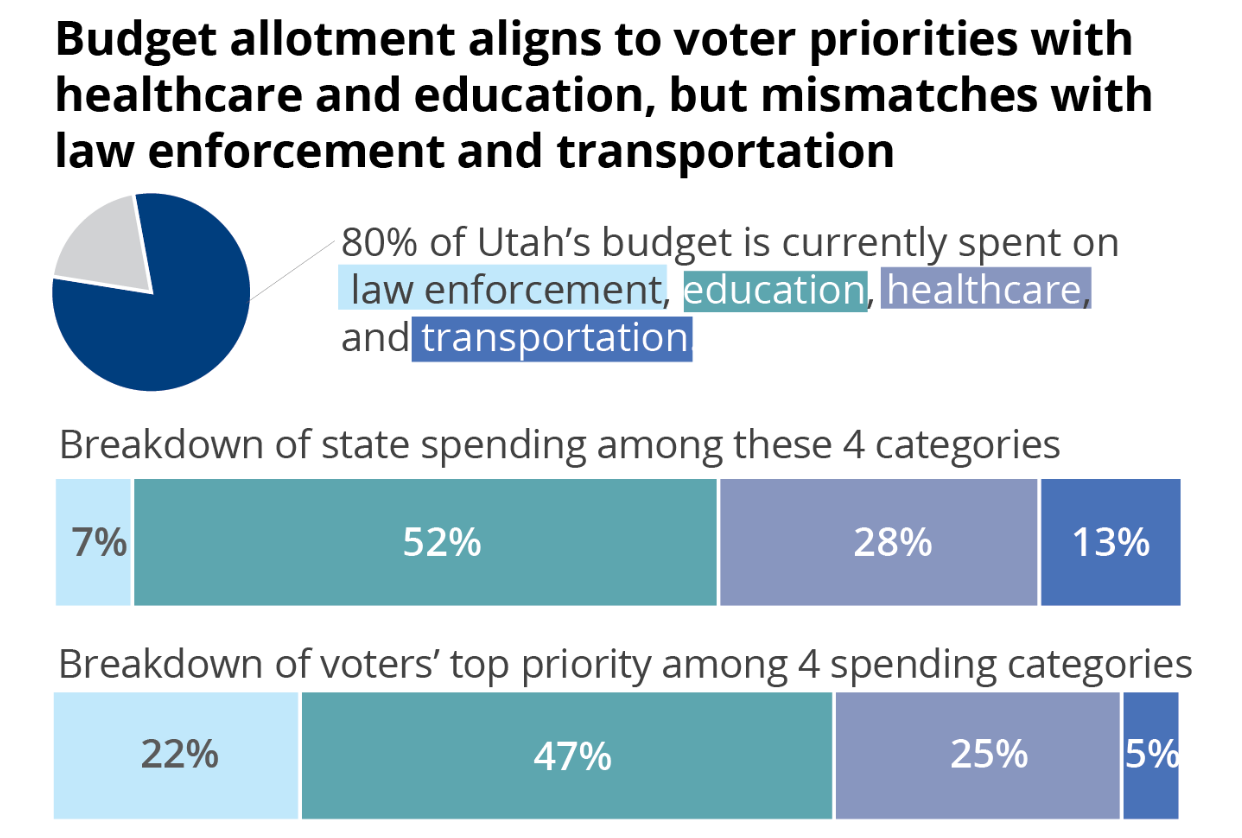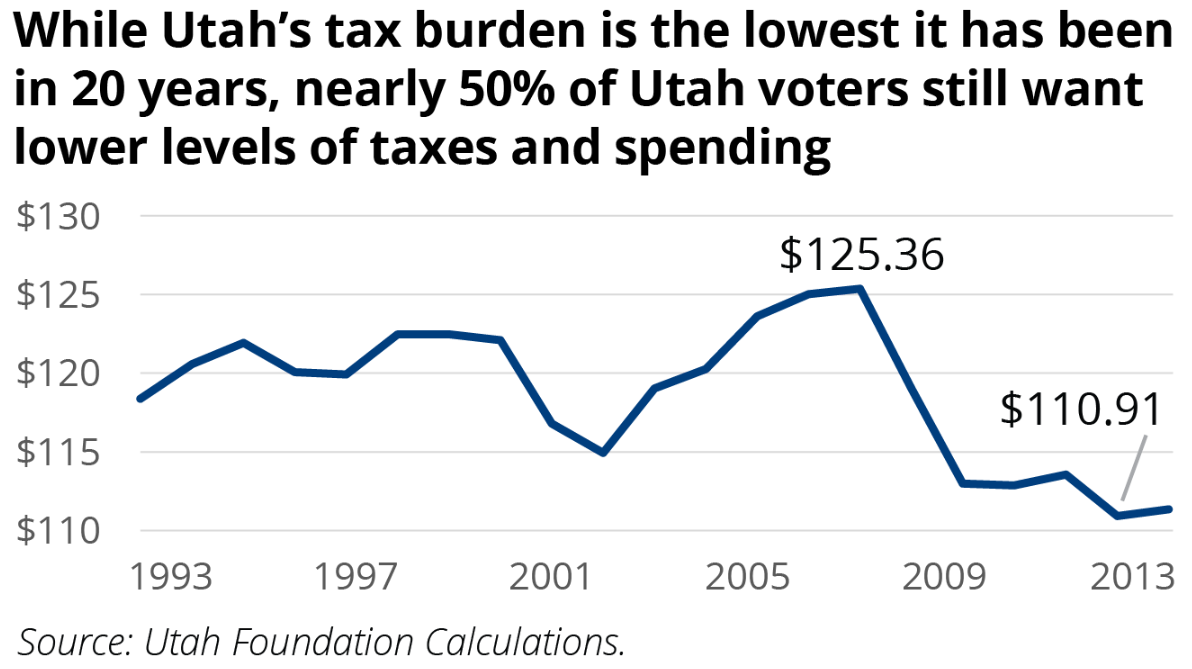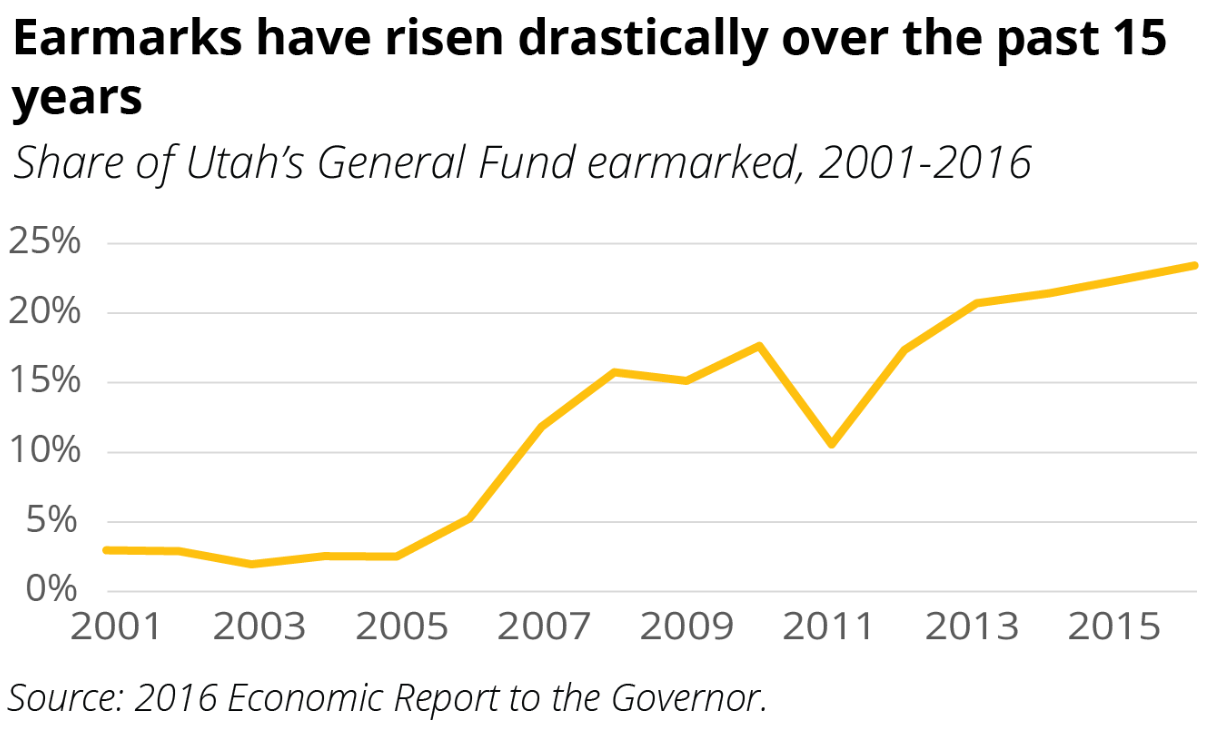State taxes and government spending has been a top priority for voters in every Utah Priorities Project. Because taxation is both explicitly controlled by the government and represents the principal form of interaction between voters and their state and local governments, it is no surprise this topic is a perennial concern.
SURVEY RESPONSES
Seven percent of respondents from the Utah Priorities Project’s initial open-response survey mentioned either taxes or government spending as one of their top two concerns. Three-quarters of these respondents mentioned taxes, most stating that they were too high. One commenter thought they were too low – especially for “polluting companies” – and several respondents recommended restructuring the tax burden in one way or another.
The other quarter of respondents addressed government spending. Most commenters who explained themselves wanted tax revenue spent more efficiently rather than reducing or increasing spending.
WHO ARE THE MOST CONCERNED?
When asked about their level of concern with state taxes and government spending, conservative Utah voters were more likely to be concerned than liberal voters. Utahns with lower educational attainment were more concerned than to those with more education. Full-time employed voters were also more concerned when compared to self-employed voters, retirees, or stay-at-home parents.
TOO MUCH TAXATION AND SPENDING?
More than twice as many voters agreed than disagreed that “Utah should reduce taxes and reduce spending” (47% to 20%). Similar to the previous question, groups with higher levels of support for reductions in taxes and spending were conservative voters, voters with lower levels of education, and full-time workers (when compared to retirees).
WHAT SHOULD UTAH FOCUS ON?
Respondents were asked to select their top priority for government spending among four broad spending categories – education, transportation, law enforcement, and healthcare. Nearly half of Utah voters (47%) selected education as their top priority for government spending.
While support for transportation and education were fairly constant across the ideological spectrum, support for prioritizing law enforcement and healthcare varied widely by ideology. Only 13% of very conservative Utah voters prioritized healthcare, as compared to 53% of very liberal voters. By contrast, not one very liberal Utah voter prioritized law enforcement, as compared to 45% of very conservative voters.

While income levels did not seem to be related to voters’ prioritization of transportation or law enforcement, it was linked to education and healthcare. Only 17% of those making more than $75,000 prioritized healthcare while 37% of those making under $50,000 responded similarly. Just over half (53%) of those making over $75,000 prioritized education compared to 40% of those making under $50,000.
The four priorities account for 80% of Utah’s 2016-2017 budget. When excluding the remaining 20% Utah’s budget, the share of the state budget spent on education and healthcare is similar to the share of Utah voters who prioritize those categories.1 However, three times as many Utah voters would prioritize government spending on law enforcement than law enforcement’s current share of the state budget among these top four budget items. On the other hand, Utah’s current share of spending on transportation is more than twice as high as the share of Utahns who would prioritize government spending on transportation.
UTAH’S TAX BURDEN

State and local taxes directly impact nearly every Utahn. As of 2013 – the latest year with data available – for every $1,000 Utahns earned in income, Utahns paid an average of $111.36 in state and local taxes.2 When comparing Utah’s tax burden to those of other states, it ranks in the middle of the pack at 25th.
Utah’s tax burden in 2012 marked the lowest tax burden seen in the past two decades – $110.91 per $1,000 of personal income. This was driven primarily by the income and sales tax cuts in 2007. Even with lower taxes, nearly half of Utah voters support still lower levels of state taxes and government spending.
A lower tax burden means Utahns have more disposable income and are better able to provide for themselves and their families. At the same time, a lower tax burden potentially threatens the ability of the government to provide essential services. Previous Utah Foundation research has found that much of the recent decrease in tax burden is the result of a decreasing education funding effort – or the amount of education spending per $1,000 of personal income.3 Many feel like this makes a bad situation worse as Utah already has the nation’s lowest level of per capita student spending.4
UTAH’S GENERAL FUND
Looking forward, there is some question to Utah’s ability to pay for priorities such as higher education, law enforcement, and healthcare services. These priorities all rely, at least in part, on Utah’s General Fund which is powered by Utah’s sales tax. The first threat to these services is Utah’s sales tax itself. First, individuals are purchasing fewer goods (which are taxable) and instead purchasing more services (which are not taxable).5 Second, many of the goods that are purchased are made online, where many retailers are not required to collect sales tax. Rather, individuals are supposed to pay sales tax on these purchases through the annual income tax filing process, though few Utahns do so. These factors decrease the sales tax collected and leave the General Fund with less revenue.

In addition to falling sales tax revenue, an increasing portion of that revenue cannot be used for higher education, healthcare, or law enforcement. In recent years, Utah legislators have expanded the number of earmarks that automatically channel an increasing amount of money to specific uses. Subsequently, less money remains to be divided among other services. While these earmarks allow budget stability for favored programs (primarily transportation in this case), it reduces the ability of other programs to compete for those funds. If 95% of Utah voters prioritize either healthcare, education or law enforcement above transportation, they might prefer that transportation needs be considered alongside other priorities rather than receive a favored status.
Policymakers are attempting to address the problem of a shrinking General Fund. First, Utah is one of many states encouraging the federal government to find a way to help states collect sales tax from online sales. In addition, the Utah Tax Review Commission was reorganized in 2015 after a four-year hiatus specifically to evaluate the earmarking process. The commission recommended that 98% of current earmarks be terminated and funded through a different process. The commission also recommended future earmarks have either a sunset provision or a review period to ensure transparency in the budgeting process.6 However, lawmakers did not accept the commission’s recommendation during the 2016 Legislative Session.
This research brief was written by Utah Foundation Research Analyst Christopher Collard.
- ^ This information deals only with the state budget. Counties and cities will spend additional money on county jails, local police forces, contributions to their school districts, local health clinics, and local roads. Education includes both K-12 and higher education funding. Law enforcement includes both public safety and criminal justice spending. Healthcare spending is medical and health related spending by the Social Services Committee. Transportation funding includes Debt Service paid by the Transportation Investment Fund of 2005. Budget information can be found from: State of Utah, Office of the Legislative Fiscal Analyst – Profile. “All sources of finance by account and line item.” https://public.tableau.com/profile/ivan8177#!/vizhome/2015GeneralSessionAppropriationsSummary/AppropriationsSummary (accessed September 12, 2016); Office of the Legislative Fiscal Analyst. “Budget of the State of Utah and related appropriations: 2016-2017.” 2016. http://le.utah.gov/interim/2016/pdf/00002225.pdf (accessed September 12, 2016)
- ^ Utah Foundation calculates the state and local tax burden per $1,000 of personal income. Mandatory fees are included as part of the calculation. For more methodological details see our last report on Utah’s tax burden: Collard, Christopher. “Easing the Burden: Utah Tax Burden Taking Lowest Share of Income in 20 Years.” 2015. https://www.utahfoundation.org/uploads/rr726.pdf (accessed September 12, 2016)
- ^ Kroes, Stephen Hershey. “Public schools shoulder the burden of tax cuts.” 2015. https://www.utahfoundation.org/2015/02/public-schools-shoulder-burden-tax-cuts/ (accessed September 12, 2016)
- ^ Weinstein, Matthew. “What’s still eating Utah’s General Fund? Unfunded earmarks are undermining the budget process and affecting Utah families and children.” 2014. http://www.utahchildren.org/images/pdfs/2014/UnfundedEarmark.pdf (accessed September 12, 2016)
- ^ Valentine, John L., Leif G. Elder, and Bryant R. Howe. “Utah’s shrinking sales tax base and its relevance to future policy decisions: How will we finance tomorrow’s needs?” 2015. Presentation to the 2015 Legislative Policy Summit on November 19, 2015. http://le.utah.gov/interim/2015/pdf/00005284.pdf (accessed September 12, 2016)
- ^ Utah Tax Review Commission. “Earmarks of the state sales and use tax: Report to Revenue and Taxation Interim Committee.” November 18, 2015. http://le.utah.gov/interim/2015/pdf/00005293.pdf (accessed September 12, 2016)


